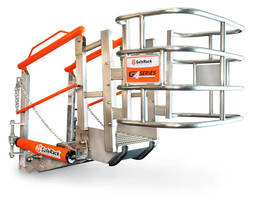Chemical Lime Finds the Answer to Its Fall-Protection Needs

Hydrated lime manufacturer upgrades to G4 Series gangway for truck-loading area
SUMTER, SC, July 1, 2009-Unbeknownst to many, the mining and refining of limestone is one of the building-block commodities of our nation's economy. The use of lime-a limestone by-product produced by heating natural limestone to very high temperatures-has evolved over the centuries, from mainly being used in building and agricultural applications to now being applicable to many sophisticated manufacturing and environmental uses. In fact, lime rates among the top five chemical compounds produced in the United States on an annual basis.
When it comes to the production of lime, one of the companies that sets the standard is Chemical Lime Company, Fort Worth, TX. Founded in 1966, Chemical Lime opened its first limestone quarry near Clifton, TX, in 1968 and began producing lime in 1971. In 1981, the Lhoist Group, Brussels, Belgium, Europe's leading lime producer, made an initial investment in Chemical Lime and in 1998 acquired full ownership. Under the Lhoist Group's leadership, Chemical Lime Company has expanded to consist of a network of 19 lime-production plants and 29 terminals, operating in a total of 20 states, plus Canada and Mexico.
Chemical Lime's Brooksville Plant in Brooksville, FL, located about 30 miles north of Tampa, produces hydrated lime, which is a dry-powdered lime made from the slaking of limestone with water. Seventy percent of the hydrated lime produced by the Brooksville Plant is used for flue-gas treatments for coal power plants. This flue-gas desulfurization is used to remove sulfur dioxide from smokestack emissions, leading to a healthier environment. The other 30 percent of hydrated lime that is produced at Brooksville is used in industrial wastewater treatment, where it neutralizes a variety of industrial waste streams, and as a reagent for environmental-remediation projects.
Overseeing the operations at the Brooksville Plant is Hanspeter Dietiker, who is the facility's Manager of Terminal Operations. In this position, he not only is responsible for monitoring the production of the hydrated lime, but also ensuring that it is loaded safely and efficiently onto outbound trucks. Part of this job is seeing that the drivers who are tasked with climbing to the tops of the trucks and opening the pneumatic hatch before loading are kept safe from slip-and-fall incidents. It's a process that takes place hundreds of times a week.
To ensure this safety, in 2004 Dietiker contracted with SafeRack LLC, for a single-hatch truck-loading gangway that would be easier and more convenient to operate-not to mention safer-than the facility's existing harness-and-lifeline safety setup. After that gangway was damaged recently, it has been retrofitted with SafeRack's G4 Series gangway technology, which uses a cutting-edge metal-stamping process to create a stronger gangway that is at the same time lighter and smoother to operate.
"The gangway is being used around the truck hatches," explained Dietiker. "We go up on the truck, open the hatch, load the truck, then the truck goes on the scale. After that, we use the gangway to go back up on the truck and either close the hatch, or if the load needs more, fill them up, go back to the scale, weight them again, make sure the weight is right and then go back up and close the hatch when it is."
The benefits of this self-contained gangway system are readily apparent to Dietiker, who even recommends SafeRack equipment to other plants in the Chemical Lime family when their operators are looking for a safety upgrade. G4 gangways are constructed using metal-stamping technology and a tool-and-die process to cut out pieces of aluminum, which are then bent into the required shape, eliminating the need for as many welds and creating a stronger, more durable gangway. Other features of the G4 equipment include spring-loaded gangway and platform operation, slip-resistant tread on the stairs, powder-coated handrails and mid-rails, heavy-duty bumpers and four-rail design for maximum fall protection.
"The SafeRack gangway gives the truck drivers a lot of freedom to work and still feel safe on top of the truck," said Dietiker. "They are totally surrounded by the gangway and even when they trip, they won't fall off. There's no hassle with a harness and lifeline; all they do is walk up the stairs, tilt the gangway onto the truck and walk out there."
Dietiker also points to the rapid response he received from SafeRack after the recent need for a quick gangway replacement and the company's ability to go above-and-beyond the call of duty to see that his operation was up and running in short order as two more benefits inherent in a SafeRack system.
"The customer service is excellent," he said. "We stay in touch and once a month we get a phone call to see if everything is fine. They are a really nice company to work with."
For more information on any of SafeRack's products or solutions, please contact Tom Semiklose, Vice President Sales, at (866) 761-7225 or tsemiklose@saferack.com, or visit www.SafeRack.com.
SafeRack, LLC, is committed to providing stronger, safer and easier-to-handle truck and railcar loading-rack and fall-protection equipment. Headquartered in Sumter, SC, SafeRack has more than 200 years of combined experience in offering the food/pharmaceutical, specialized chemical, pulp and paper, building products, plastics, cement, mining, petroleum, biodiesel and ethanol industries high-quality equipment that has been customized for each customer's unique loading applications. For more information, please visit www.saferack.com.
SafeRack, LLC
730 Electric Drive
Sumter, SC 29153
(866) 761-7225
www.saferack.com




